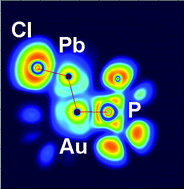Computational prediction of Au(i)–Pb(ii) bonding in coordination complexes and study of the factors affecting the formation of Au(i)–E(ii) (E = Ge, Sn, Pb) covalent bonds†
Abstract
We have studied computationally the Au–M (M = Ge, Sn, Pb) bonding trends in a series of model systems [(PH3)3Au–(MCl3)] (M = Ge (4), Sn (5), Pb (6)). For this, we have fully optimized the model systems at the MP2 level of theory, computing the Au–M bonding energy at the equilibrium distances applying the counterpoise (cp) correction to the basis-set superposition error (BSSE) and performing a natural energy decomposition analysis (NEDA). Furthermore, a topological analysis of the electron density using QTAIM, ELF and DORI tools was performed. In order to provide further insights on the possibility of predicting the existence of Au(I)–Pb(II) donor bonds, Density Functional Theory calculations using the pbe functional and including dispersion corrections (DFT-D3/pbe) were performed on three model systems, [(PR3)3Au–(PbCl3)] (R = CH3 (7), H (8), CF3 (9)). This study also includes the corresponding NEDA calculations and the topological analysis of the electron density, which provides information about the Au–Pb bond, but also about the supporting weak ligand–ligand interactions. Overall, the study provides information about the factors affecting the formation of stabilizing Au(I)–Pb(II) covalent bonds.



 Please wait while we load your content...
Please wait while we load your content...